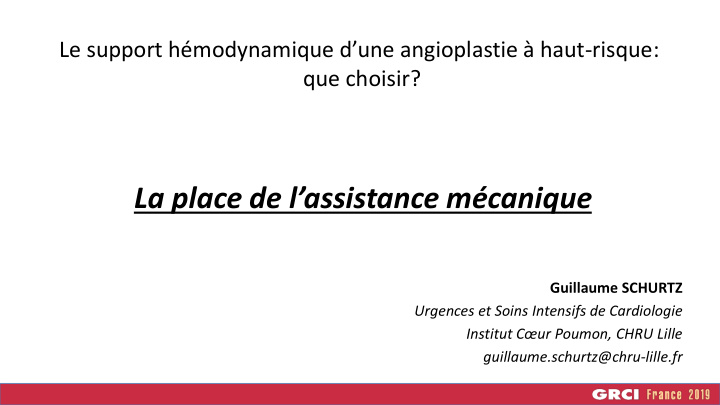



Le support hémodynamique d’une angioplastie à haut -risque: que choisir? La place de l’assistance mécanique Guillaume SCHURTZ Urgences et Soins Intensifs de Cardiologie Institut Cœur Poumon, CHRU Lille guillaume.schurtz@chru-lille.fr
DÉCLARATION DE LIENS D'INTÉRÊT AVEC LA PRÉSENTATION Speaker's name : Guillaume SCHURTZ, Lille ABIOMED
HR-PCI definition remains elusive … Depressed LV function Electrical instability Cardiogenic shock All components LVEDP PH associated … with increased mortality Hemodynamic compromise LM Age Last potent vessel Comorbidities Patient MVD Complex CAD PAD comorbidities Calcification ACS presentation Previous CABG Prior surgery SYNTAX … …
Mechanical support: one size does not fit all Cardiogenic shock HR-PCI CA Each device has its own features and limitations … - Flow - Coronary perfusion - Cannula size - Anticoagulation - Insertion - Adverse effects - Unloading - Costs …
What could happen to you during HR-PCI … Primary Objectives Reperfusion No-reflow injury 1. Reducing LV work and MvO2 2. Ensuring end-organ and myocardial AKI Cardiac arrest perfusion 3. Anticipation!!!! Technical Cardiogenic difficulties shock MCS Dysrhythmias Stunning Appropriate device selection
Is IABP a good candidate? BCIS-1 study N = 301 HR PCI LVEF≤30% BCIS score>8 12% cross-over CRISP-AMI study N = 337 Anterior STEMI w/o shock EF=47% 8% cross-over Perera, D. et al. Elective IABP during high-risk PCI. JAMA (2010) Perera, D. et al. Long-term mortality data from the BCIS-1 study. Circulation (2013) Patel, RM. et al. IABC and infarct size in patients with acute anterior MI without shock. JAMA (2011)
IABP: Game Over? Exhausted autoregulation and persistent ischemia is required for IABP efficacy Better patient selection? CRISP-AMI substudy ST ≥ 15mm ST-R<50% SEMPER FI trial = negative (n = 100) Schampaert, S. et al. IABP support in the isolated beating porcine heart in non ischemic and ischemic heart failure. Artif Organs (2015) Van Nunen, LX. et al. IABP reduces mortality in a large anterior MI complicated by persistent ischemia. EuroIntervention (2015)
Impella: a cardio-circulatory support Outflow Inflow (aortic root) (Ventricle) Aortic valve Flow AOP EDV, EDP Wall Mechanical Tension Work Microvascular Resistance Coronary Flow O 2 Supply Cardiac Output O 2 Demand Hemodynamic Protection LV unloading
Use of pVADs during PCI + CS in the US Other MCS 1. Decline in IABP use 2. Increase of others MCS IABP 3. MCS patients are the sickest one No MCS 4. MCS use is clustered at a small number of hospitals Does it translate into a clinical benefit? pVAD IABP Khera, R. et al. Trends in the use of pVADs. JAMA Intern Med (2015) Sandhu, A. et al. Use of MCS in patients undergoing PCI. Circulation (2015)
pVADs improves hemodynamics, but … PROTECT II Trial N= 448 Impella 2.5 vs IABP ULM or 3VD and LVEF<30% Non-emergent PCI Never forget, MCS could be harmful (but observational studies … ) O’Neil , WW. et al. A prospective, randomized trial of hemodynamic support with Impella 2.5 vs IABP in HR-PCI. Circulation (2010) Amin, AP. et al. The evolving landscape of Impella use in the US among patients undergoing PCI with MCS. Circulation (2019) Dhruva, SS. Utilization and outcomes of Impella vs IABP among patients with AMI complicated by cardiogenic shock undergoing PCI. AHA (2019)
However, pVADs are not dead!! MACCE with a more relevant MI definition Impella support permitted a more complete revascularization Potential link with MACCE Dangas, GD. et al . Impact of hemodynamic support with Impella 2.5 vs IABP on prognostically important clinical outcomes in patients undergoing HR PCI. Am J Cardiol (2014) Kovacic, JC. et al. Patients with 3VCAD and impaired LV function undergoing PCI with Impella 2.5 have improved 90-day outcomes. J Interv Cardiol (2015) Burke,DA. et al. The value of left ventricular support in patients with reduced LVEF undergoing extensive revascularization. JACC Interv (2019)
However, pVADs are not dead!! 1. A learning effect could have influenced PROTECT II results Similar outcomes despite higher-risk patients in the pVAD group N=139 (24) HR-PCI w/o shock or STEMI N=198 (69) pVAD improves outcomes 2. Are powerful devices more efficient? Shamekhi, J. et al. Impact of hemodynamic support in patients undergoing HR-PCI. Am J Cardiol (2019) Henriques, JPS. et al. Evaluating the lurining curve in the PROTECT II trial. Am Heart J (2014) Ameloot, K. et al. New-generation MCS during HR-PCI. EuroIntervention (2019)
Why not VA-ECMO? - Loads the heart - 4-5L of actual flow - Can be modulated (TPR, contractility) - Independent of heart function - Is a circulatory support - More severe CS or CA - Biventricular / respiratory failure Increases wall stress Lack of RCT for HR-PCI+++ Exact prevalence and incidence of complications is ascertain, but remains high
You must avoid vascular complications! - Mortality Major impact of bleeding +++ - Length of stay - Health care costs Experience, US guidance and closure devices can help you … Redfors, B. et al. Mortality, length of stay, and cost implications of procedural bleeding after percutaneous interventions using large-bore catheters. JAMA Cardiol (2017)
Conclusion: take home messages 1. Patient selection is of paramount importance for HR-PCI Consensual definition 2. Which patient would benefit mosts? Careful evaluation before device selection 3. Don’t forget « after PCI » Look beyond coronary arteries … ! 4. Minimizing complications Perform HR PCI with experienced operators Fascination of devices may dampen your thinking …
Merci de votre attention
Recommend
More recommend